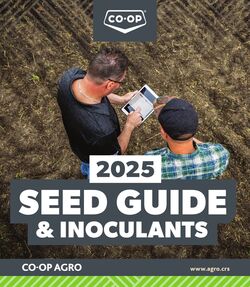













Products in this flyer
CONSUMER TRENDS The growing popularity of plant-based proteins is contributing to higher demand for pulses. With pulse processors setting up shop across the prairie provinces — and with continued innovation in the food sector — Canadian pulse growers are facing expanding market opportunities Ramping up pulse production is easier said than done, of course. Growers looking to increase Canada's pulse acreage will have to keep in mind the needs of food processors, agronomic realities and other factors. Regardless, industry stakeholders say continued research into pulse genetics and production should help the industry meet demand “As members of the Grow Team, Co-op agronomists have plenty of experience helping growers manage their pulse crops,” says Brendan Mowchenko, Grow Team member at Grassroots Co-op in Limerick, Saskatchewan. “it starts with helping the grower find which inoculant best fits their needs." Demand for Pulses: The Big Picture The growth in demand for plant-based foods, and more specifically in plant-derived proteins, is both à national and global phenomenon According to Global Market Insights, the global market for alternative proteins generally is expected to grow at18.5 per cent per year from 2022 to 2028, resulting in a global market value of an estimated 193.5 billion USD. The total demand for all proteins is expected to double by 2054, reaching 943.5 million metric tons. Annual global sales of plant-based meat alternatives, reads the report, have grown an average of eight per cent year-over-year since 2010, with projections forecasting that 20 per cent of meat will consist of plant-based and “clean meat" within 25 years At the retail level, consumers are increasingly interested in plant-based alternatives. Improving Pulse Varieties These are large numbers to be sure, but according to Robert Semeniuk— a farmer from Northeast Alberta and chair of Alberta Pulse Growers — Canada's farm sector is well suited to match the challenge. There are ways of improving the odds, though, including diversifying breeding programs to account for both agronomic needs and the nutritional traits desired by food manufacturers. “There is some varietal work being done based on the pulse varieties we have already. As this builds, it's another box breeders are going to check off," says Semeniuk, highlighting the need for higher protein levels as a particularly important focus for plant breeders. Indeed, the general industry understanding is pulse processing companies — many of which are currently developing facilities across Manitoba, Saskatchewan
| Name | Details |
|---|